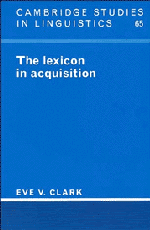1 - The lexicon: words old and new
Published online by Cambridge University Press: 05 July 2011
Summary
Words make a language. They are used to talk about everything, from beekeeping to bicycling, from navigation to international banking. They supply us with the means for everyday talk about our surroundings and activities, about people, objects, and places, about relations, properties, and states of being. We need them to communicate about events and ideas, technology, science, philosophy, and art. The stock of words speakers can draw on in a language is the lexicon. The present study is concerned with how children acquire a lexicon.
Words come first in language acquisition. Once children have some words, they begin to make generalizations about kinds of words – words for persons, places, and things, say, compared with words for actions and states. Children need words to instantiate syntactic categories, whether at the word level (noun, verb, adjective) or at the phrase level (noun phrase, verb phrase). And they must have words to realize grammatical relations like ‘subject-of’ or ‘direct-object-of,’ or mark such relations through agreement between subject and verb, say, for number and person. Without words, there would be no sound structure, no word structure, no syntax. The lexicon is central in language, and central in the acquisition of language.
- Type
- Chapter
- Information
- The Lexicon in Acquisition , pp. 1 - 18Publisher: Cambridge University PressPrint publication year: 1993



